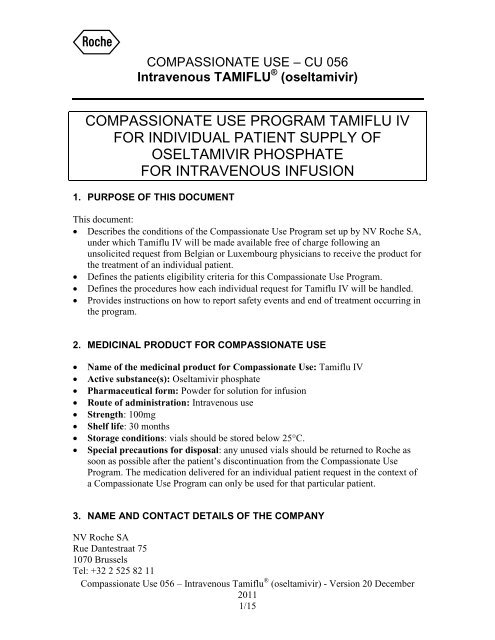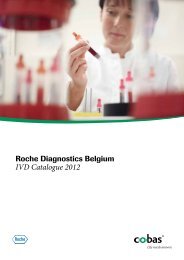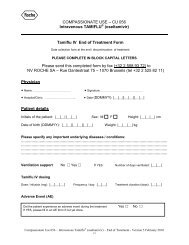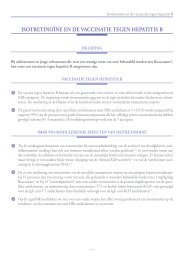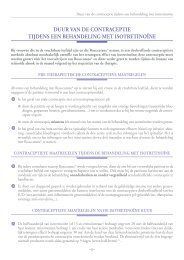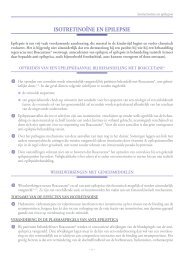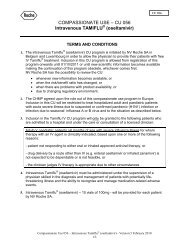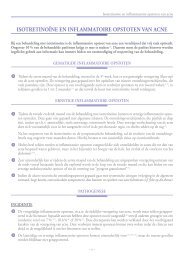Intravenous TAMIFLU
Intravenous TAMIFLU
Intravenous TAMIFLU
You also want an ePaper? Increase the reach of your titles
YUMPU automatically turns print PDFs into web optimized ePapers that Google loves.
COMPASSIONATE USE – CU 056<br />
<strong>Intravenous</strong> <strong>TAMIFLU</strong> ® (oseltamivir)<br />
COMPASSIONATE USE PROGRAM <strong>TAMIFLU</strong> IV<br />
FOR INDIVIDUAL PATIENT SUPPLY OF<br />
OSELTAMIVIR PHOSPHATE<br />
FOR INTRAVENOUS INFUSION<br />
1. PURPOSE OF THIS DOCUMENT<br />
This document:<br />
Describes the conditions of the Compassionate Use Program set up by NV Roche SA,<br />
under which Tamiflu IV will be made available free of charge following an<br />
unsolicited request from Belgian or Luxembourg physicians to receive the product for<br />
the treatment of an individual patient.<br />
Defines the patients eligibility criteria for this Compassionate Use Program.<br />
Defines the procedures how each individual request for Tamiflu IV will be handled.<br />
Provides instructions on how to report safety events and end of treatment occurring in<br />
the program.<br />
2. MEDICINAL PRODUCT FOR COMPASSIONATE USE<br />
<br />
<br />
<br />
<br />
<br />
<br />
<br />
<br />
Name of the medicinal product for Compassionate Use: Tamiflu IV<br />
Active substance(s): Oseltamivir phosphate<br />
Pharmaceutical form: Powder for solution for infusion<br />
Route of administration: <strong>Intravenous</strong> use<br />
Strength: 100mg<br />
Shelf life: 30 months<br />
Storage conditions: vials should be stored below 25°C.<br />
Special precautions for disposal: any unused vials should be returned to Roche as<br />
soon as possible after the patient’s discontinuation from the Compassionate Use<br />
Program. The medication delivered for an individual patient request in the context of<br />
a Compassionate Use Program can only be used for that particular patient.<br />
3. NAME AND CONTACT DETAILS OF THE COMPANY<br />
NV Roche SA<br />
Rue Dantestraat 75<br />
1070 Brussels<br />
Tel: +32 2 525 82 11<br />
Compassionate Use 056 – <strong>Intravenous</strong> Tamiflu ® (oseltamivir) - Version 20 December<br />
2011<br />
1/15
COMPASSIONATE USE – CU 056<br />
<strong>Intravenous</strong> <strong>TAMIFLU</strong> ® (oseltamivir)<br />
4. DRUG ELIGIBILITY CRITERIA FOR THIS CU PROGRAM<br />
This product is actually under evaluation in clinical trials. On January 21 2010, the<br />
CHMP granted positive opinion for a Compassionate use program of Tamiflu intravenous<br />
formulation within the EU.<br />
5. SCOPE AND PATIENTS ELIGIBILITY CRITERIA FOR THIS CU PROGRAM<br />
IV oseltamivir should be considered only to treat critically ill adults and children older<br />
than 1 year of age with acute severe illness due to suspected or confirmed pandemic<br />
(H1N1) infection or infection due to seasonal influenza A or B virus.<br />
Specifically, oseltamivir infusion should only be used for the following patients who are<br />
admitted to a hospital and under the care or consultation of a licensed clinician (skilled in<br />
the diagnosis and management of patients with potentially life-threatening illness and the<br />
ability to recognise and manage medication-related adverse events):<br />
<br />
Adult or paediatric patients > 1 year of age with severe influenza illness for<br />
whom therapy with an IV agent is clinically indicated, based upon one or more of<br />
the following reasons:<br />
(1) patient not responding to either oral or inhaled authorised antiviral<br />
medication, or<br />
(2) drug delivery by a route other than IV (e.g. enteral oseltamivir or inhaled<br />
zanamivir) is not expected to be dependable or is not feasible, or<br />
The patient or legally authorized consent giver should provide written consent; for<br />
unconscious patients unable to provide consent for treatment with oseltamivir IV a<br />
surrogate decision maker must sign for the patient.<br />
Pregnant patients may be considered for treatment with oseltamivir IV only if the<br />
potential benefit justifies the potential risk to the fetus.<br />
For infants below 1 year of age, no dose recommendations can be provided, given the<br />
lack of data. Should a physician decide to treat an infant < 1 year of age, based upon a<br />
benefit /risk assessment, the doses which will be investigated in clinical study NP25138<br />
are provided in Section 9 for information.<br />
Oseltamivir IV should not be used in patients on probenecid as probenecid inhibits OAT<br />
function.<br />
Oseltamivir IV should not be administered to patients with clinical evidence of severe<br />
hepatic decompensation or with a history of allergy to the medication.<br />
In case of renal impairment, special dosing instructions must be followed (see further).<br />
Compassionate Use 056 – <strong>Intravenous</strong> Tamiflu ® (oseltamivir) - Version 20 December<br />
2011<br />
2/15
COMPASSIONATE USE – CU 056<br />
<strong>Intravenous</strong> <strong>TAMIFLU</strong> ® (oseltamivir)<br />
Treatment with oseltamivir IV maybe replaced by treatment with oral Tamiflu ® at any<br />
time at the discretion of the treating physician.<br />
6. CONDITIONS FOR DISTRIBUTION<br />
Tamiflu IV should be prescribed only by clinicians skilled in the diagnosis and<br />
management of patients with potentially life-threatening illness.<br />
7. DURATION OF THE COMPASSIONATE USE PROGRAM<br />
Inclusion in this CU program is allowed from registration of this program onwards<br />
until 31/05/2012 or until new scientific information becomes available making the<br />
continuation of this program obsolete, whichever comes first.<br />
NV Roche SA has the possibility to review the CU:<br />
<br />
<br />
<br />
<br />
whenever new information becomes available, or<br />
when the risk/benefit ratio has changed, or<br />
when there are problems with product availability, or<br />
due to changing regulatory environment.<br />
8. DRUG REQUEST PROCEDURE<br />
The intravenous Tamiflu ® (oseltamivir) CU program is initiated in order to allow the<br />
physician to provide IV Tamiflu ® free of charge on an individual patient basis.<br />
The physician needs to fill in and sign the physician's request form (see section 5 for<br />
details on the declaration included in the form).<br />
All documents related to this Compassionate Use Program (program description,<br />
physician request forms, unsolicited written requests, discontinuation of drug forms, …)<br />
will be archived by NV Roche SA and the requesting physician for at least 10 years.<br />
<br />
Physicians request form<br />
This form will be signed by the requesting physician and returned to NV Roche SA.<br />
<br />
Patient consent form<br />
Patient must accept participation in Compassionate Use Program and provide a<br />
written informed consent.<br />
Compassionate Use 056 – <strong>Intravenous</strong> Tamiflu ® (oseltamivir) - Version 20 December<br />
2011<br />
3/15
COMPASSIONATE USE – CU 056<br />
<strong>Intravenous</strong> <strong>TAMIFLU</strong> ® (oseltamivir)<br />
<br />
End of treatment form<br />
This form should be used to document and report any patient end of treatment or<br />
discontinuation from the Compassionate Use Program.<br />
9. DOSING GUIDELINES<br />
Tamiflu ® has been shown to be effective when administered in the first 48 hours after<br />
onset of symptoms. In every patient an attempt must be made to administer the first<br />
dose within 48 hours. It should be noted that the OC exposures observed when OP is<br />
administered through a nasogastric tube are comparable to those obtained with oral<br />
administration and associated with efficacy [1]. A treating physician must consider the<br />
nasogastric route as an alternative to oseltamivir IV.<br />
A guideline for oseltamivir IV treatment dosing based on age is presented below.<br />
Adolescents and adults > 13 years<br />
100 mg IV BID (twice daily) infused at a constant rate over 2 hours<br />
Children 1 to 12 years<br />
Weight ≤ 23 kg: 3 mg/kg<br />
Weight > 23 to 40 kg: 2.5 mg/kg<br />
Weight > 40 kg: same as adults – 100 mg<br />
The doses listed immediately above should be infused at a constant rate over 2 hours<br />
BID (twice daily).<br />
Infants
COMPASSIONATE USE – CU 056<br />
<strong>Intravenous</strong> <strong>TAMIFLU</strong> ® (oseltamivir)<br />
The doses listed immediately above should be infused at a constant rate over 2 hours<br />
BID (twice daily). These doses were selected based upon preliminary results from<br />
modeling and simulation.<br />
The usual duration of oseltamivir treatment is 5 days. If the investigator believes that the<br />
duration of treatment should be extended, this will be at the discretion of the treating<br />
clinician.<br />
Premature infants<br />
The dosing information provided above is not intended for premature infants with a<br />
gestational age of less than 37 weeks (by menstrual date).<br />
9.1. Dosing for patients with moderate/Severe Renal Impairment<br />
No dose adjustments/modifications are required for patients whose CrCl is > 60 ml/min<br />
(adults) or > 60 ml/min/1.73 m2 (adolescents aged 13 to < 18).<br />
The dose or dose and dosing frequency of oseltamivir must be adjusted in patients<br />
with moderate renal impairment (CrCl > 30 to 60 ml/min – adults or > 30 to<br />
60 ml/min/1.73 m 2 – adolescents aged 13 to < 18), severe renal impairment (CrCl 10 to<br />
30 ml/min – adults or 10 to 30 ml/min/1.73 m 2 – adolescents aged 13 to < 18) and for<br />
patients with renal failure undergoing Continuous Renal Replacement Therapy (CRRT),<br />
intermittent Haemodialysis (HD) or Continuous Ambulatory Peritoneal Dialysis (CAPD).<br />
Refer to Table 1 for dosing in these patients.<br />
In adults and adolescents, the dose and frequency of administration should be decreased<br />
to 40 mg IV over 2 hours twice daily in patients with moderate renal impairment (CrCL<br />
30 to 60 ml/min – adults, or 30 to 60 ml/min/1.73 m 2 – adolescents aged 13 to < 18).<br />
In adults and adolescents, the dose and frequency of administration should be decreased<br />
to 40 mg IV over 2 hours once daily in patients with severe renal impairment (CrCL<br />
between 10 to 30 ml/min – adults, or 10 to 30 ml/min/1.73 m 2 – adolescents aged 13 to<br />
< 18).<br />
In the event that CrCL falls below 10 ml/min/1.73 m 2 and the patient is receiving renal<br />
replacement therapy, refer to Section 9.2 for dosing guidance.<br />
If the investigator feels that renal function is compromised, dosing may be decreased to<br />
40 mg once daily or withheld until CrCL results (measured or calculated) are available.<br />
Dosing may then be resumed, as appropriate, based on CrCL. However, it is vital that<br />
Compassionate Use 056 – <strong>Intravenous</strong> Tamiflu ® (oseltamivir) - Version 20 December<br />
2011<br />
5/15
COMPASSIONATE USE – CU 056<br />
<strong>Intravenous</strong> <strong>TAMIFLU</strong> ® (oseltamivir)<br />
dosing not be inappropriately withheld for extended periods of time especially in the first<br />
3 days of treatment when viral titers may be high.<br />
CrCL should be estimated using the modified Schwarz equation for adolescents and the<br />
Cockcroft-Gault method for adults (see Appendix 3).<br />
9.2. Renal Failure<br />
Adolescents and adults > 13 years of age<br />
Very limited clinical data are currently available following oral oseltamivir<br />
administration in patients undergoing CRRT. Based on an in vitro continuous<br />
venovenous hemofiltration (CVVH) study, the absolute OC adsorption was low and can<br />
probably be disregarded. The sieving coefficient of OC is close to 1, therefore the<br />
clearance of OC can be estimated from the ultrafiltration rate.<br />
Several different kinds of CRRT exist, including CVVH, continuous arterio-venous<br />
hemofiltration (CAVH) or hemodiafiltration (CVVHDF or CAVHDF). Drug clearance<br />
differences are generally not clinically significant between different types of CRRT at the<br />
same total effluent (dialysate + formed ultrafiltrate) rates [2]. The total effluent rate can<br />
therefore be used to approximate the OC clearance by CRRT (CL CRRT ). Depending on the<br />
type of CRRT, the effluent rate can range from approximately 10 to 50 ml/min with the<br />
target dose of delivered therapy being 35 ml/h/kg (approximately 35 ml/min) [2]. Any<br />
residual renal function the patient has can be estimated and added to CL CRRT to estimate<br />
total renal clearance. It is assumed that the contribution of active tubular secretion to OC<br />
renal clearance would be negligible in these patients. Based on this range, the<br />
recommendations for dosing in patients on CRRT are in Table 1.<br />
The doses provided below for patients on intermittent HD or CAPD are estimated based<br />
on data from two pharmacokinetic studies of oral oseltamivir administered to subjects<br />
with ESRD undergoing HD or CAPD. These dosing regimens are based on a 5-day<br />
treatment period. If required, the drug may be given for up to a 10-day treatment period,<br />
but patients should not be dosed for a period greater than 10 days. In these patients the<br />
drug continues to accumulate with each dose administered.<br />
Compassionate Use 056 – <strong>Intravenous</strong> Tamiflu ® (oseltamivir) - Version 20 December<br />
2011<br />
6/15
COMPASSIONATE USE – CU 056<br />
<strong>Intravenous</strong> <strong>TAMIFLU</strong> ® (oseltamivir)<br />
Table 1<br />
Severe/Moderate<br />
Renal Impairment<br />
(CrCl)<br />
CRRT<br />
Dosing in Adults and Adolescents (13 years of age and<br />
older) with Moderate/Severe Renal Impairment, on CRRT,<br />
Intermittent Hemodialysis or Continuous Ambulatory<br />
Peritoneal Dialysis<br />
Type of Patient<br />
Intermittent Hemodialysis (HD)<br />
Dose<br />
(mg)<br />
Frequency<br />
Duration<br />
(Days)<br />
> 30 to 60 ml/min 40 mg over 2 hours q 12 h 5<br />
10 to 30 ml/min 40 mg over 2 hours q 24 h 5<br />
< 10 ml/min Not recommended (no data available)<br />
> 30 ml/min 1 40 mg over 2 hours q 12 h 5<br />
10 to 30 ml/min 1 40 mg over 2 hours q 24 h 5<br />
40 mg over 2 hours<br />
After each<br />
HD Session 2 5<br />
Continuous Ambulatory<br />
Peritoneal Dialysis (CAPD) 3 40 mg over 2 hours one dose 4 5<br />
1 Total renal clearance of oseltamivir carboxylate should be estimated by adding together CL CRRT and<br />
residual renal function (CL CRRT + CrCl).<br />
2 Hemodialysis – The first 40 mg dose should be administered within 96 hours of onset of symptoms, then<br />
administer a 40 mg dose 1 hour after each HD session during the 5-day treatment period.<br />
3 Data derived from studies in continuous ambulatory peritoneal dialysis (CAPD) patients; the clearance of<br />
oseltamivir carboxylate is expected to be higher when automated peritoneal dialysis (APD) mode is used.<br />
Treatment mode can be switched from APD to CAPD if considered necessary by a nephrologist.<br />
4 A single 40 mg intravenous dose of oseltamivir is expected to provide therapeutic exposure for the full<br />
5-day treatment period.<br />
Less than 13 years<br />
No dosing recommendations are available for this age group.<br />
Compassionate Use 056 – <strong>Intravenous</strong> Tamiflu ® (oseltamivir) - Version 20 December<br />
2011<br />
7/15
COMPASSIONATE USE – CU 056<br />
<strong>Intravenous</strong> <strong>TAMIFLU</strong> ® (oseltamivir)<br />
10. PREPARATION, ADMINISTRATION AND MONITORING OF OSELTAMIVIR<br />
IV THERAPY<br />
10.1. IV Formulation<br />
The reconstituted drug product (with 1.1 mL of Water for Injection) has a concentration<br />
of 100 mg/mL of OP, is hypertonic (osmolarity approximately 687 mosm/kg) with a pH<br />
of about 4 (specified as 3.0 - 5.0). The compatibility of OP with 0.9 % sodium chloride<br />
has been established. When diluted to a final volume of 25 mL with 0.9 % sodium<br />
chloride, the resulting concentration of about 4 mg/mL has an osmolarity almost similar<br />
to that of plasma. Infusion site pain has been observed in a clinical trial when OP was<br />
administered at a concentration of 8 mg/mL. The compatibility of OP with other drugs<br />
and intravenous solutions other than 0,9% sodium chloride has not been established.<br />
OP is incompatible with reducing sugars (e.g. glucose). Oseltamivir IV is<br />
theoretically incompatible with solutions containing calcium ions, due to the risk of<br />
calcium phosphate precipitation.<br />
Monitoring of vital parameters and the infusion site for thrombophlebitis and<br />
extravasation are mandatory when OP is administered intravenously.<br />
10.2. Preparation<br />
In preparing the IV solution for administration, always take care to minimize direct<br />
exposure of oseltamivir to the skin and eyes. A responsible qualified individual should<br />
dispense the correct dose according to the dosing instructions given in Section 8 above.<br />
Oseltamivir IV is supplied as a bulk supply of open-label vials containing formulation<br />
Ro 064-0796/F09-01. Each 3 mL glass vial, with a 13 mm butyl rubber stopper, contains<br />
157.6 mg of oseltamivir phosphate, corresponding to 120.0 mg of oseltamivir free base as<br />
a lyophilizate; this provides a 20% overage to compensate for the non-removable volume<br />
of reconstituted solution.<br />
Dissolve vial content with 1.1 ml of water for injection.<br />
<br />
<br />
<br />
This concentrated solution must be further diluted with 100 ml of 0.9% sodium<br />
chloride prior to administration by infusion to give a final concentration of<br />
1 mg/ml for administration.<br />
For adults and children > 40kg, the whole volume (100 ml) should be<br />
administered over 2 hours.<br />
For children < 40kg, calculate the required volume for administration (1 mg/ml),<br />
based on dosing instructions outlined in Section 9, using the concentration of<br />
1 mg/ml. Discard any volume in excess of this, and administer the calculated<br />
volume over 2 hours.<br />
Compassionate Use 056 – <strong>Intravenous</strong> Tamiflu ® (oseltamivir) - Version 20 December<br />
2011<br />
8/15
COMPASSIONATE USE – CU 056<br />
<strong>Intravenous</strong> <strong>TAMIFLU</strong> ® (oseltamivir)<br />
For example, a child aged ≥ 1 year with a weight of 20 kg should be dosed at<br />
3 mg/kg. This would require 60 mg for each dose, which equates to 60 ml of<br />
1 mg/ml solution. Thus 40 ml of the 1 mg/ml solution should be discarded prior to<br />
commencement of the IV infusion.<br />
In cases where the volume of infusion needs to be decreased in adults, the final<br />
concentration of oseltamivir should not exceed 2 mg/ml. Dilution should be as follows:<br />
dilute 1 ml of the reconstituted solution to a final volume of 50 ml with 0.9% sodium<br />
chloride. In children the concentration should never exceed 1 mg/ml.<br />
10.3. Administration of Oseltamivir IV<br />
Oseltamivir IV should be administered by a slow volume and time controlled<br />
infusion over 2 hours between 12h intervals.<br />
PASSIVE DRIP INFUSION IS NOT ALLOWED.<br />
10.3.1. Vascular access<br />
A multi-port (multi-lumen) central venous line or a peripherally inserted long line (or<br />
central catheter) is ideal. Alternatively, a peripheral venous canula may be used, provided<br />
the site of infusion is clearly visible for inspection.<br />
When administered through a peripheral venous canula, if there is any evidence of<br />
extravasation or thrombophlebitis the infusion must be immediately stopped, It may be<br />
resumed at an alternate site.<br />
10.3.2. Infusion Pump<br />
An infusion pump, which can be programmed to accurately administer at the desired rate<br />
of infusion should be used. The rate of infusion should be such that each dose is<br />
administered over 2 hours. For small volumes of infusion, a piston driven syringe pump<br />
is recommended. The dead space in the IV tubing between syringe pump and patient<br />
should be as small as possible. After the infusion is completed, this dead space must be<br />
slowly cleared over several minutes.<br />
10.3.3. Co-administration of Other Drugs<br />
Oseltamivir IV should be administered through one lumen alone. Co-administration of<br />
other IV drugs via other lumens of a multi-lumen port, or intravenous lines is allowed.<br />
Co-administration implies simultaneous administration of more than one drug through the<br />
same port/lumen of a vascular access. The simultaneous use of different ports in a<br />
multi-lumen central line is not considered co-administration.<br />
The only drug/IV solution that oseltamivir has been shown to be compatible with is 0.9%<br />
sodium chloride. Oseltamivir may therefore be co-administered only with 0.9% sodium<br />
chloride.<br />
Compassionate Use 056 – <strong>Intravenous</strong> Tamiflu ® (oseltamivir) - Version 20 December<br />
2011<br />
9/15
COMPASSIONATE USE – CU 056<br />
<strong>Intravenous</strong> <strong>TAMIFLU</strong> ® (oseltamivir)<br />
Other saline infusion solutions (e.g. Ringer’s Lactate Solution) have not been tested for<br />
compatibility.<br />
Oseltamivir is incompatible with reducing sugars i.e. glucose or fructose. Oseltamivir as<br />
a primary amine reacts with reducing sugars forming degradation products in situ. The<br />
reconstituted solution must not be co-administered or added to infusion solutions<br />
containing reducing sugars.<br />
The compatibility of oseltamivir has not been evaluated with any other IV drug.<br />
Therefore no IV medications can be co-administered with oseltamivir IV.<br />
10.4. Systemic Monitoring during the Infusion<br />
Before the start of<br />
infusion:<br />
During the infusion and<br />
for 1 hour following the<br />
infusion:<br />
Blood pressure and heart rate for all patients.<br />
Adults and adolescents (13 years and older)<br />
Heart rate should be monitored with audible alarm limits<br />
(alarm limits depending on pre-infusion heart rates) using<br />
continuous telemetry. Additionally blood pressure must be<br />
measured at 15, 30, 60, 90 and 120 minutes following the<br />
start of the infusion and 60 minutes following the end of the<br />
infusion (approximately 180 minutes after the start of the<br />
infusion). Pulse oximetry may also be used per investigator<br />
discretion.<br />
Children (1 – 12 years)<br />
Heart rate should be monitored with audible alarm limits<br />
(alarm limits depending on pre-infusion heart rates and<br />
appropriate for age of patient) using continuous telemetry.<br />
Additionally in older children, blood pressure must be<br />
measured at 15, 30, 60, 90 and 120 minutes following the<br />
start of the infusion and 60 minutes following the end of the<br />
infusion (approximately 180 minutes after the start of the<br />
infusion). In toddlers and younger children, blood pressure<br />
may be monitored at the discretion of the physician. Pulse<br />
oximetry may be used per investigator discretion.<br />
The infusion must be held for all unexplained changes in heart rate, blood pressure or<br />
pulse oximetry.<br />
Compassionate Use 056 – <strong>Intravenous</strong> Tamiflu ® (oseltamivir) - Version 20 December<br />
2011<br />
10/15
COMPASSIONATE USE – CU 056<br />
<strong>Intravenous</strong> <strong>TAMIFLU</strong> ® (oseltamivir)<br />
10.5. Infusion Site Monitoring<br />
The pH of the initially reconstituted solution (with 1.1 mL of Water for Injection) is<br />
about 4 (specified as 3.0 - 5.0). After further dilution with normal saline solution<br />
to2 mg/mL the measured pH was approximately 4.6. At this dilution the medication is<br />
considered isotonic (osmolarity similar to that for 0.9% sodium chloride).<br />
Peripheral veins with comparatively slow blood flow may be irritated by extremes of pH.<br />
Phlebitis, thrombophlebitis or infiltration of the tissues may result with loss of the vein<br />
for therapy and possibly tissue damage . When catheters are positioned in the central<br />
veins, blood flow is fast and achieves rapid dilution of injected substances<br />
If the patient receives oseltamivir IV through a peripheral venous canula, the site of<br />
insertion of the canula must be examined periodically. If there are any reactions<br />
(thrombophlebitis, extravasation) at the site of insertion, the site of infusion must be<br />
changed.<br />
11. WARNINGS AND PRECAUTIONS<br />
Drugs (e.g. probenecid), which inhibit OAT should not be co-administered with<br />
oseltamivir.<br />
Under no circumstances can oseltamivir be administered if the concentration exceeds 4<br />
mg/mL. Please refer to Section 10.2. for additional information on the preparation of<br />
oseltamivir for IV infusion.<br />
OP should be administered over 2 hours. An infusion pump which can be programmed<br />
to accurately administer at the desired rate of infusion should be used. Residual OP in IV<br />
lines must be cleared gradually over several minutes (depending on the dead space of the<br />
line and the concentration of OP). PASSIVE DRIP INFUSION IS NOT ALLOWED.<br />
Oseltamivir must NEVER be administered by bolus (“IV push”) injection. Please<br />
refer Section to 10.3. for details on the administration of oseltamivir IV.<br />
Systemic monitoring with some combination of heart rate, blood pressure and oxygen<br />
saturation (pulse oximetry), based on the age of the patient is mandatory. If there are any<br />
unexplained changes in any of these parameters, the infusion must be withheld. Please<br />
refer to Section 0. for additional information.<br />
Compassionate Use 056 – <strong>Intravenous</strong> Tamiflu ® (oseltamivir) - Version 20 December<br />
2011<br />
11/15
COMPASSIONATE USE – CU 056<br />
<strong>Intravenous</strong> <strong>TAMIFLU</strong> ® (oseltamivir)<br />
If OP is administered through peripheral venous access, the site of administration must be<br />
monitored frequently for extravasation, thrombophlebitis and infusion site pain. If there is<br />
any evidence for extravasation or thrombophlebitis the infusion must be stopped<br />
promptly and resumed at an alternate site. Please refer to Section 10.5 for additional<br />
information.<br />
For the established safety information on oral Tamiflu® please refer to the<br />
Summary of product Characteristics and Package Insert of the oral product<br />
11.1. Contraindications<br />
Hypersensitivity to the active substance or any of the excipient.<br />
11.2. Interaction with other medicinal products<br />
Tamiflu IV should not be used in patients on probenecid as probenecid inhibits organic anion<br />
transporters (OAT) function.<br />
11.3. Pregnancy and lactation<br />
Pregnant patients may be considered for treatment with Tamiflu IV only if the potential benefit<br />
justifies the potential risk to the fetus.<br />
11.4. Incompatibilities<br />
The only IV solution that oseltamivir has been shown to be compatible with is 0.9%<br />
sodium chloride. Oseltamivir is incompatible with reducing sugars i.e. glucose or<br />
fructose. Oseltamivir as a primary amine reacts with reducing sugars forming degradation<br />
products in situ. The reconstituted solution must not be co-administered or added to infusion<br />
solutions containing reducing sugars. Oseltamivir IV is theoretically incompatible with solutions<br />
containing calcium ions, due to the risk of calcium phosphate precipitation. The compatibility of<br />
oseltamivir has not been evaluated with any other IV drug.<br />
11.5. Overdose<br />
If Tamiflu IV is administered at a concentration exceeding 4 mg/mL, the medication-related<br />
adverse events should be closely monitored, especially vital signs and symptoms and infusion site<br />
side effect.<br />
12. PRECLINICAL DATA<br />
Key findings from preclinical studies and their implication for use in humans are<br />
presented below.<br />
Compassionate Use 056 – <strong>Intravenous</strong> Tamiflu ® (oseltamivir) - Version 20 December<br />
2011<br />
12/15
COMPASSIONATE USE – CU 056<br />
<strong>Intravenous</strong> <strong>TAMIFLU</strong> ® (oseltamivir)<br />
12.1. Toxicity in Animal Studies<br />
In animal studies, no toxicity was observed at levels of oseltamivir which are 126- and<br />
11-fold higher based on C max and AUC, respectively for the IV dose of 100 mg in human<br />
adults. This margin is expected to be similar for children 1 year of age.<br />
12.2. Fatality in Animal Studies Following Bolus Administration<br />
A bolus injection of 100 mg/kg of oseltamivir, resulted in death of some mice, while the<br />
same dose at a slower infusion rate was well tolerated.<br />
OP should be administered over 2 hours. Residual OP in IV lines must be cleared<br />
gradually over several minutes (depending on the dead space of the line and the<br />
concentration of oseltamivir). Oseltamivir must NEVER be administered by bolus<br />
(“IV push”) injection.<br />
12.3. Risk from IV Extravasation<br />
In a local tolerance study in rabbits, the administration of OP at oseltamivir<br />
concentrations of 4 and 8 mg/mL by perivenous injection was well tolerated. However,<br />
administration of 16 mg/mL by perivenous injection was associated with erythema,<br />
discoloration, and an increased incidence of severity of hemorrhage at the injection site.<br />
If OP is administered through a peripheral venous canula, the site of administration must<br />
be monitored frequently for extravasation, thrombophlebitis and infusion site pain.<br />
13. SAFETY REPORTING<br />
Reporting of spontaneously mentioned adverse events (AEs) has to be done to either<br />
one of the following:<br />
1. the FAMHP, by means of the dedicated yellow form:<br />
in paper copy to:<br />
Centre National de Pharmacovigilance/Nationaal Centrum voor<br />
Geneesmiddelenbewaking<br />
Eurostation II (8° étage/verdieping)<br />
Victor Hortaplein 40 B10<br />
1060 Bruxelles-Brussel<br />
OR<br />
electronic version to:<br />
adversedrugreactions@fagg-afmps.be<br />
Compassionate Use 056 – <strong>Intravenous</strong> Tamiflu ® (oseltamivir) - Version 20 December<br />
2011<br />
13/15
COMPASSIONATE USE – CU 056<br />
<strong>Intravenous</strong> <strong>TAMIFLU</strong> ® (oseltamivir)<br />
Both, the paper version and the electronic version of the yellow form can be<br />
downloaded from the following website link: http://www.fagg-afmps.be.<br />
(French: Usage humain/Pharmacovigilance – Collecte des données…)<br />
(Dutch: Menselijk gebruik /Geneesmiddelenbewaking – Gegevens verzamelen…)<br />
2. NV Roche SA, by means of the Spontaneous Adverse Event fax cover sheet and<br />
Adverse Event form provided in the CU file.<br />
This form should be sent by fax to NV Roche SA Drug Safety Brussels (fax:<br />
02/525.84.66).<br />
Details on requirements and timelines of safety reporting to NV Roche SA can be<br />
found in the section 'Physician's commitments (§ 6, 7, 8)', which is part of the<br />
Physician Request Form.<br />
Oseltamivir IV is restricted to medical prescription on a compassionate use basis.<br />
Compassionate Use 056 – <strong>Intravenous</strong> Tamiflu ® (oseltamivir) - Version 20 December<br />
2011<br />
14/15
COMPASSIONATE USE – CU 056<br />
<strong>Intravenous</strong> <strong>TAMIFLU</strong> ® (oseltamivir)<br />
14. FINANCIAL ASPECTS<br />
No financial compensation or reimbursement is foreseen for the requesting physician<br />
and/or the hospital pharmacist.<br />
15. NOTIFICATION TO CA & ETHICS COMMITTEE (EC)<br />
This Compassionate Use Program can only start after having obtained a positive EC<br />
opinion. Once a positive EC opinion obtained, the program will be submitted for<br />
approval to the FAMHP (Dpt R&D) for authorization. If no objection is received within 2<br />
weeks, the program will start.<br />
This dossier is submitted to the FAMHP and the following EC:<br />
Name: Universitair Ziekenhuis Antwerpen (UZA)<br />
Address: Wilrijkstraat 10, 2650 Edegem<br />
Contact: Prof. Dr. Patrick Cras – Mrs Annelies Van Looy<br />
E-mail: annelies.van.looy@uza.be<br />
16. REFERENCES<br />
1. Taylor WRJ, Thinh BN, Anh GT, Horby P, Wertheim H, et al. 2008 Oseltamivir Is<br />
Adequately Absorbed Following Nasogastric Administration to Adult Patients with<br />
Severe H5N1 Influenza. PLoS ONE 3(10): e3410.<br />
doi:10.1371/journal.pone.0003410.<br />
2. Mueller BA. Smoyer WE. Challenges in developing evidence-based drug dosing<br />
guidelines for adults and children receiving renal replacement therapy. Clin<br />
Pharmacol Ther. 2009;86:479-482.<br />
Compassionate Use 056 – <strong>Intravenous</strong> Tamiflu ® (oseltamivir) - Version 20 December<br />
2011<br />
15/15


